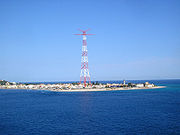
Pylons of Messina
Encyclopedia

Overhead power line
An overhead power line is an electric power transmission line suspended by towers or utility poles. Since most of the insulation is provided by air, overhead power lines are generally the lowest-cost method of transmission for large quantities of electric energy...
across the Strait of Messina
Strait of Messina
The Strait of Messina is the narrow passage between the eastern tip of Sicily and the southern tip of Calabria in the south of Italy. It connects the Tyrrhenian Sea with the Ionian Sea, within the central Mediterranean...
, between the Rizziconi
Rizziconi
Rizziconi is a comune in the Province of Reggio Calabria in the Italian region Calabria, located about 80 km southwest of Catanzaro and about 45 km northeast of Reggio Calabria...
substation in Calabria
Calabria
Calabria , in antiquity known as Bruttium, is a region in southern Italy, south of Naples, located at the "toe" of the Italian Peninsula. The capital city of Calabria is Catanzaro....
on the Italian mainland and the Sorgente substation in Sicily
Sicily
Sicily is a region of Italy, and is the largest island in the Mediterranean Sea. Along with the surrounding minor islands, it constitutes an autonomous region of Italy, the Regione Autonoma Siciliana Sicily has a rich and unique culture, especially with regard to the arts, music, literature,...
.
Design
The two pylons, built in 1957, are both 232 metres (761.2 ft) high freestanding steel towers. Each pylon stands on an 8 metres (26.2 ft) tall cross-shaped base and is equipped with a crossbar that carried four conductors at a height of 212 metres (695.5 ft), and another V-shaped structure at the top which carried two additional conductors and also the ground wires. In contrast to more conventional pylon design, the corners of the pylons are arranged diagonally along the direction of the course of the line. The Pylons of Messina were the model for the Elbe Crossing 1Elbe crossing 1
Elbe Crossing 1 is a group of masts providing an overhead crossing of a 220 kV three-phase alternating current electric powerline across the River Elbe. Constructed between 1959 and 1962 as part of the line from Stade to Hamburg north, it consists of four masts:* Each of the two portal masts...
in Germany and were, until the completion of Elbe Crossing 2
Elbe crossing 2
Elbe Crossing 2 is a group of pylons providing overhead lines for four 380 kV three-phase alternating current circuits across the German river Elbe...
, the tallest pylons of the world.
After their completion, the period of the oscillation of the structures and their maximum deflections were determined in a very unusual manner: engineers mounted three rockets with a thrust of 9800 kilonewtons on top of the pylons and ignited them.
To cross Strait of Messina, the overhead power lines had to have a very large span of more than 3 kilometres (1.9 mi). Because of the span, and the maritime traffic in the strait below, the conductors needed to have sufficient minimum height above ground, and had to be constructed with a great tensile strength
Tensile strength
Ultimate tensile strength , often shortened to tensile strength or ultimate strength, is the maximum stress that a material can withstand while being stretched or pulled before necking, which is when the specimen's cross-section starts to significantly contract...
. This required the use of steel
Steel
Steel is an alloy that consists mostly of iron and has a carbon content between 0.2% and 2.1% by weight, depending on the grade. Carbon is the most common alloying material for iron, but various other alloying elements are used, such as manganese, chromium, vanadium, and tungsten...
cables as conductors even though steel has the disadvantage of poorer electrical conductivity than normal aluminium
Aluminium
Aluminium or aluminum is a silvery white member of the boron group of chemical elements. It has the symbol Al, and its atomic number is 13. It is not soluble in water under normal circumstances....
overhead power lines. The danger of oscillations caused by wind did not allow the usage of bundled conductors. Thus, the original overhead line across the Strait did not meet modern operational standards and the entire power line was replaced in 1994 by a submarine cable
Submarine power cable
Submarine power cables are major transmission cables for carrying electric power below the surface of the water. These are called "submarine" because they usually carry electric power beneath salt water but it is also possible to use submarine power cables beneath fresh water...
.
Today
After their decommission as power lines, the now-unused pylons remain with protected status as historical monuments and are used for meteorologicalMeteorology
Meteorology is the interdisciplinary scientific study of the atmosphere. Studies in the field stretch back millennia, though significant progress in meteorology did not occur until the 18th century. The 19th century saw breakthroughs occur after observing networks developed across several countries...
measurements, high altitude rescue training and telecommunications. Since 2006, it has been possible to visit the pylon on the Sicilian shore; however, one has to use a stairway with 1,250 steps to get to the top.
Messina Strait submarine cable
As the overhead line crossingOverhead line crossing
An overhead line crossing is the crossing of an obstacle—such as a traffic route, a river, a valley or a strait—by an overhead power line. The style of crossing depends on the local conditions and regulations at the time the power line is constructed. Overhead line crossings can...
did not afford the requirements in 1994 a 380 kV-cable was laid, which starts at 38°14′28.78"N 15°41′19.17"E.
External links
- The pylon on Sicilia 38.265883 °N 15.650904 °W
- The pylon in Calabria 38.245052 °N 15.682983 °W

